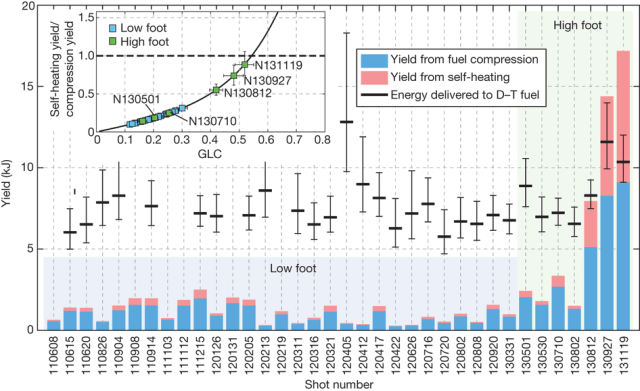Tweaks at NIF generate good results – to come: spectacular shots
NIF (National Ignition Facility) at Lawrence Livermore National Laboratory in California published results during the dark of winter that are exciting, show astounding differences from all their previous announcements. This is our Part 1 of 2 on the what and why of these data. Their promising results came out in February, in different journals with different but complimentary results; a note in Physics Review Letters, (get a free PDF copy!), a Letter in the journal Nature (behind a paywall), and Daniel Clery wrote a news summary in the journal Science (perhaps easier to access).
During my recent blogging sabbatical, there have been many events worthy of comment. Many, like this, have been very positive and leave me in an upbeat feeling. NIF results area good place to start our discussions.
In the past, LastTechAge has been pretty critical about how LLNL upper management has guided NIF operations. See our Index for other posts in the Technology-Fusion ICR thread.
It is about time to recognize the hard earned achievement that NIF Team Leader Dr. Omar Hurricane and his team have accomplished. He and 15 others are listed as authors on the encouraging – and believable – PRL paper.
Background

Fig 2: LEFT – Target: 2.3 mm (< 1/8 inch) diameter, plastic shell with frozen mixture of deuterium and tritium (DT) that is the fusion fuel. CENTER – Holhraum chamber 5.4 mm cylinder diameter (<1/4 inch). Target is at center of this chamber. RIGHT – 192 separate laser beams enter chamber ends and strike the walls, not the target: • walls radiate x-rays • x-rays strike target • target compresses 100× smaller • core Temp > 100 M degrees and energy released by fusion. Image source: LLNL
 Fig 2 is a set of images from an earlier post. NIF used plastic target shells lined with a thin layer of cryogenic DT ice (D deuterium, T tritium). The target is placed in the hohlraum chamber and all 192 beams were focused on the end holes.
Fig 2 is a set of images from an earlier post. NIF used plastic target shells lined with a thin layer of cryogenic DT ice (D deuterium, T tritium). The target is placed in the hohlraum chamber and all 192 beams were focused on the end holes.
A hohlraum is the key part of indirect drive because the laser’s purpose is to generate high x-rays flux that ablates the shell and causes the target( A.K.A pellet or capsule) to implode.
The Fusion process (Fig 3) is the merging of the D with T to form a helium nucleus.
In the end, we get a stable high energy helium nucleus (A.K.A. alpha particle), and a fast moving neutron.
Click any graph to enlarge it.
The Good Data
Fig 4 shows the data that is causing the celebrations. These data were used in the February reports. The graph is similar to those in the PRL and Nature publications, but is from the 2013 Dec presentation to the NIF management Advisory Council by John Edwards, Assoc. Dir. for ICF.
First: These new data have the highest fusion energy yield they ever achieved; several shots generated more energy in fusion than actually reached the pellet. They do report that the collapsed core was a bit lower in density than expected.
Second: The important part of the good news is that the high energy alpha particles from each fusion event significantly heated the remaining collapsed core plasma. This is called self-heating and happens when the core density is high enough to slow down the alphas and absorb some of their energy. They are on the way to significant self-heating, what is frequently called ignition, where fusion reactions generate the power to cause subsequent reactions. Ignition means the collapsed core “can do it alone;” it needs no outside driver power to make fusion power. Is this the first time any ICF shot has demonstrated self-heating?
NIF is definitely on the right track, now.
These data are not fully optimized, and many things might be adjusted/modified for even better results. Nothing negative here. It will be exciting to watch the NIF team make the adjustments to the target, hohlraum and beamlines to reach their promised Q=1 (generated output energy equals what was put in). They are at or near energy output/input breakeven (19 kJ), but the goal is and always has been 5 MJ, that needed to get back all the energy that was initially put in by the NIF facility.
They have finally found their first turn in their long trek through the murky and complicated parameter space, the most exciting game of old-fashioned Physics Adventure/Zork imaginable. I wish them bon voyage. Stay tuned here for Part 2.
……………………………….
Charles J. Armentrout, Ann Arbor
2014 May 25
Listed under Technology … Technology > ICF/IFE
Have a comment? Click on the title of this post, go to bottom, let us know.
Related posts: Click the INDEX button under the Banner picture



